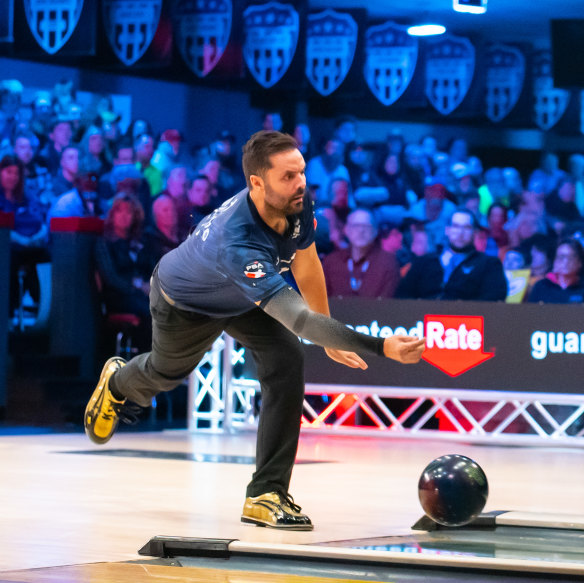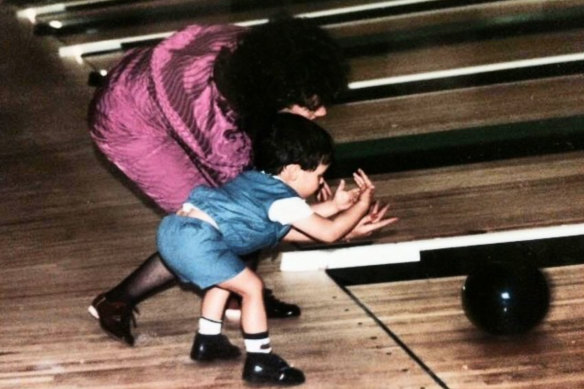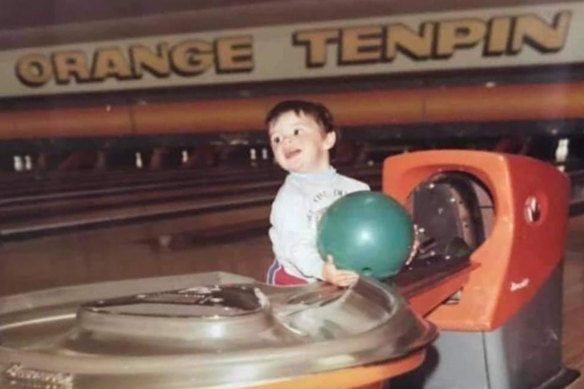This was published 8 months ago
Tenpin bowling’s GOAT is an Aussie. His technique’s a global game-changer
In Australia, he’s a mild-mannered father of four. But in the world of tenpin bowling, Jason Belmonte is the Roger Federer or Don Bradman of the game – with a controversial two-handed technique that’s being adopted around the globe.

Belmonte demonstrates his two-handed bowling action.Credit: Pip Farquharson
Iam waiting at Orange train station in rural NSW for the world’s greatest ever tenpin bowler to pick me up. He’s running late, which gives me a few extra minutes to reflect, again, on all the things I do not know about bowling.
This is a very long list, but surely, I tell myself, it’s the same for most Australians? What do we as a nation know about bowling, after all? Take Jason Belmonte. He is one of our own, born here on the Central Tablelands of NSW. And he is also, without doubt, the greatest bowler the world has ever seen. He has spent the past 16 years competing on the biggest bowling stage in the world, the Professional Bowlers Association (PBA) tour in America. He has won 15 major titles (the most ever won by anybody, ever), including four United States Bowling Congress Masters titles (the most ever), four Tournament of Champions titles (the most ever), three Players Championships (the most ever), three World Championships (equalling the most ever) and seven Player of the Year awards (equalling the most ever). He has achieved these records, moreover, in a way that has made him a bowling revolutionary. In America, where he’s famous – or infamous – to millions of people, he’s been labelled a cheat, a gimmick, a “cancer” on the game. He’s also been called a phenom, a superstar, a man “on the Mount Rushmore of bowling”. Tom Clark, CEO and commissioner of the PBA, calls him “a transcendent figure in our sport”.
And yet, in Australia, I’d be willing to bet that unless you’re related to him or know him as a mate, you’ve probably never heard his name. What the PBA doesn’t realise, I think, as a mud-spattered four-door ute pulls up in the train station car park, is that Jason Belmonte – nickname Belmo – leads a double life. Here in his rural Australian home town, he’s a mild-mannered husband and father of four, going anonymously about his business. Nobody knows that he’s famous; nobody knows that beneath his 40-year-old-dad sweater and everyday trainers lie the two-toned shirt and sparkling clown shoes of a genuine bowling Superman.
The story of Jason Belmonte’s rise to greatness begins – as many superhero stories do – in early childhood. He was still a toddler when, before the bemused eyes of his parents, he began displaying the first signs of uncanny bowling ability.
Marisa and Aldo Belmonte opened Orange’s first –and still only – bowling alley in September 1983, six weeks after Belmonte’s birth. It was a wild success. “For five or six years, my parents and my [paternal] grandparents worked every shift, every day, seven days a week,” recalls Belmonte: which meant baby Jason was there every shift, every day too. Marisa remembers him falling asleep “to the sounds of bowling balls: they were his white noise”. As soon as he could walk, he was given a ball, sent over to lane 16 (on the far right-hand side of the centre, next to the wall), and left to do his thing.

The family bowling alley is still Orange’s only tenpin venue.Credit: Pip Farquharson
Bowling’s a good game for a little kid – a contained space, a machine to return the ball, and frequent opportunities to smash something over. At the time, of course, Belmonte was only two feet tall, unsteady on his feet, and using a ball that weighed half as much as he did. And so he developed a style that had never, in all of bowling history, been used successfully. One that involved using not the traditional one hand to bowl the ball, but two.
Today, the interior of Orange Tenpin Bowl looks like every bowling alley you’ve ever seen – retro colours, commercial carpet and zero natural light. (Back at the dawn of bowling, one must assume, some great tenpin god decreed that all bowling games should be played indoors, away from any stray shaft of sunlight; and all over the world ever since, this law has been faithfully obeyed.) Belmonte gets us a coffee and a piece of impressively preserved vending-machine banana bread, and I ask him to explain the intricacies of the game.
Actually, he doesn’t really get a chance to go into the intricacies, because I don’t even understand the basics. I had never realised, for instance, that all bowling lanes are oiled – literally covered with a variable pattern of oil for most of their 60-foot (18.3-metre) length. It’s this oil that changes the degree of difficulty in the game, because it alters the way the ball behaves: where, when, and to what degree it spins, slides and curves. This is why an amateur bowler in a community league might post the same score as a professional on the tour: one is playing on an oil pattern that makes their path to the pins as wide and straight as a cargo plane runway; the other is trying to negotiate the Monaco Grand Prix.
Who knew? And who knew there are hundreds – thousands – of different oil patterns, laid down in every bowling alley on earth by computerised machines? Or that those patterns are then disrupted and complicated by every ball that rolls over them? Thus, the requirements for each shot will be infinitesimally different from the last, so that in the course of a game, a bowler will have to incrementally alter his or her approach, release, shot pattern – even the ball.

En route to his comeback win in the 2023 Tournament of Champions.Credit: Al Kornspan
Speaking of balls. There are a million different weights, cores and coverstocks to choose from; balls that hook and don’t hook; heavy balls and light balls; balls for left-handers and right-handers; balls that would not be out of place in the bowling alleys of Mordor, being rolled by Saruman. Belmonte himself carries up to 24 balls with him on tour.
Added to all this bowling alchemy is one more variable: the human body. Granted, the average elite bowler may not look like the most finely tuned physical specimen on earth. But don’t let the dress pants and belt (not to mention the occasional specs, paunch or grey hair) fool you. The great bowler is a muscle-and-bone metronome, swinging a heavy object at high speed through a wide arc to a split-centimetre release point hundreds of times a tournament. And he or she (women are eligible to compete on the PBA tour alongside men, though they rarely do) must do this while running, walking, skipping or shuffling towards (but never over) the foul line.
So. This is the context of all bowling: a complex surface, over which a complex piece of equipment is propelled via a complex technique. One final detail. For as long as bowling has been played (certainly since the early 1800s, and possibly since the ancient Egyptians) the vast majority of the millions of people who play it (currently as many as 70 million a year in the USA alone) have, thanks to history, custom and coaching, used only one hand. Until Belmo.

How Belmonte’s technique started.Credit: @jbelmo/Instagram
Because he’s a good-natured person, Belmonte gets up on famous lane 16 to break down his technique for me. He begins by holding the ball close to his chest with both hands. (I am pleased – and relieved – to report that he does not smell, kiss or lick the ball. I have seen people kiss their balls for luck; I’ve read about balls manufactured with particular scents – cinnamon is apparently popular; and we’ve all seen The Jesus in The Big Lebowski: thank you, John Turturro, for an image we will never get out of our heads.) From his chest rest position, Belmonte swings the ball down by his right side as he approaches the foul line, holding it with both hands: left hand to the front of the ball, right hand beneath it. As he bends, he pulls the ball back towards his right hip – still using both hands. Then he swings it forward and, at the last moment, lifts his left hand and releases it off his right. He inserts only two fingers into the ball – second and third – and not his thumb.
As you’d expect, Belmonte looks as graceful as it’s possible to be while doing all this, but even so, it’s a disconcerting vision to a non-bowler: like watching someone swing a golf club one-handed. When I try, I feel like a chimpanzee carrying a really heavy coconut. But in fact, the two-handed technique has specific advantages over the traditional delivery. The first is rev rate: the number of times a ball spins in a minute. The higher the rev rate, the more powerful the shot, and the harder the ball hits the pins. (One of the words most associated with Belmonte is, unsurprisingly, BOOM.) The second advantage is hook: the way a ball curves at the end of its roll. Two-handers can create a very sharply angled finish, thus increasing the chances of hitting the sweet spot just behind the front pin that’s most likely to lead to a strike.

Belmonte never returned to coaching after being told to “bowl normal” as a child.Credit: Pip Farquharson
Today, these advantages are well understood – thanks in large part to the man standing in front of me. But back when he was 12 years old, thrashing all comers in the adult league on Friday nights in Orange, nobody had a clue. He was the only two-handed bowler anyone had ever seen. Almost more importantly, in true ugly duckling fashion, he was the only two-handed bowler he had ever seen. “I thought I must be the only person in the world who bowled like this,” he says ruefully. When he was in primary school, his parents offered to take him to a coaching clinic in Sydney. He was thrilled: he’d never had a coach, or a lesson, or any kind of bowling advice. “I got there, and I bowled a few balls. And the head coach said, ‘I don’t know what you’re doing here. I don’t know why you’re bowling this way, but if you ever want to have success in this game, if you ever want to represent your country, if you ever want us to help you, you’re going to have to bowl normal.’ ”
Belmonte tried for the rest of the day. “But I was miserable, and not very good. On the second day, they just let me bowl and ignored me: didn’t help me, didn’t coach me, didn’t include me in any activities.” At the end of the clinic they had a three-game tournament, and Belmonte asked if he could join in. “They were like, ‘Sure, kid.’ ”
Belmonte bowled two-handed, “against all the best young bowlers in Australia up to 18. And I won.” The prize was free entry to the following year’s clinic. “And I said, ‘Thanks guys, but I’m good.’ I declined the prize.” Belmonte grins. “I wish I’d been mature enough to give them a little wink, a little ‘How you like them apples?’ But I never went back, and I never, ever, did any clinic or had any coaching. I just went, ‘You know what? I’m going to do this by myself.’ ”
In some ways, bowling is a powerfully individual sport. Though at the grassroots level it’s often played in multi-person teams, each player’s particular game is entirely unaffected by anyone else. Nobody suffers from your mistakes; your ability to make or miss shots is unaltered by your opponent’s level of expertise. It’s one of the very few games that a rank amateur and a hardened professional can play together without frustration. With an appropriate handicap, the amateur can even win.
But this also means it can be a lonely game. Like most tennis or chess matches, there’s no need for team spirit; no reason to celebrate another player’s extraordinary skill or revolutionary technique. In fact, the impetus is all the other way: to try to stop anybody from doing anything that makes them successful – because their success often means your failure.

Winning his fourth Tournament of Champions title in the US last year.
And unlike tennis and chess, in which the rules are minutely codified and universally accepted, when Belmonte began on the PBA there were no specific rules allowing (or outlawing) two-handed bowling. The United States Bowling Congress (USBC) Playing Rules, (rule 4a, Legal Delivery) simply stated: “A delivery must be made entirely by manual means.” Manual. No word about how many manuals, as it were.
In August last year, the USBC did explicitly include and define the two-handed technique in a new rule (4f, if you’re interested). In this country, Tenpin Bowling Australia’s own rule book preserves an admirably live-and-let-live philosophy, stating that “there is no rule which limits or dictates how many hands can be used to deliver a ball, or how many hands are allowed on a bowling ball at any point of delivery.” But historically, it’s fair to say, as CEO of Tenpin Bowling Australia Ryan Edgar puts it, “there was – and still is for some people – a sense that the two-handed technique creates such a technical advantage, it must be cheating – like the double diffuser in Formula One, or Tiger Woods’ swing in golf.”
In both these cases, the sport’s governing bodies reacted by changing the rules: the F1 banning double diffusers (which increase a car’s downforce) in 2011, and golf courses lengthening and toughening holes to “Tiger-proof” them from 2000 onwards. “I guess they could have changed the rules here, too,” says Edgar. “But they didn’t. And personally, for me, I think they made the right call. Bowling is bowling.” As USBC executive director Chad Murphy put it, in an email to Good Weekend: “Just because a certain new style has success over a period of time doesn’t mean that style should be excluded. It means we should explore all the factors that led to it and learn from it. We should also congratulate the winners instead of suggesting that accomplishments are somehow lesser than those in the past.”
This criticism – that he’s not a “real” bowler, like the greats of history – has followed Belmonte his entire career. “I always hated it, as any mother would,” recalls Marisa Belmonte of the early days, when grown men would complain about her young son’s technique. “I felt like slapping people! But we always said, ‘Don’t let other people’s weakness dominate you. Do it your way, and do it well.’ ” And maybe the early knocks helped toughen him up: there’s a video made when he was 12 or 13, on which he’s asked about his future bowling plans. “I wanna be the best in the world,” he says, grinning. “And be real rich.”
‘It was the loud voice of America. It was really intense … And the better I bowled, the louder it got, and the more people tried to ban me.’
Jason Belmonte
During his teens and 20s, Belmonte began bowling in state and national tournaments, then increasingly overseas on the Asian and European tours. He played on the junior and adult Australian teams in the same year, the coaches of both caving in to the inevitable. “I remember the state selector saying, ‘I’d love you on my team, because you are destroying everyone.’” Soon afterwards, he bought a round-the-world ticket to bowl in Singapore, Germany, France, Belgium, Sweden, then home through Malaysia. The prize money wasn’t massive, but as a young guy it was enough to live on, and the experience was a stepping stone to the big league; the holy grail; the final key to both riches and recognition. America.

With parents Aldo and Marisa. “Do it your way, and do it well,” his mum told him.Credit: Pip Farquharson
For at least the past 100 years, the centre of world bowling has been the USA. It’s where most of the world’s recreational bowlers are found, and where the biggest professional bowling tour, the PBA tour, operates.
Big is the operative word here. Once upon a time, bowling was truly big, even by American standards: in the 1950s it was one of the first sports ever to appear on TV, and during the 1960s and ’70s, top American bowlers were being paid twice as much as NFL footballers. Indeed, the first ever athlete to sign a million-dollar endorsement deal was a bowler, “Mr Bowling” Don Carter, in 1964. From the 1980s onwards, however, the trend in bowling’s popularity has been largely downwards, in both fan base and remuneration. In Australia, though some two million people have bowled at least once in the past year, there are fewer than 25,000 registered players nationally. Even at the PBA level, the average earnings for a professional bowler on the tour these days are only between $US20-50,000 (about $30-75,000) a year. (The average NFL player these days, by contrast, earns $US2.8 million or about $4.1 million.)
But it’s not all bad. These earnings don’t take into account sponsorship and endorsement deals – of which Belmonte has several, as well as a hand in video games and other bowling-themed merch – or the much higher earning potential of the very top players. Belmonte, for instance, was the PBA tour’s highest earner in 2022, with $US302,525 in prize money alone; last year he was third, with $US338,825.
The PBA tour, like golf or tennis, is divided into a calendar of regular events, punctuated by majors. Belmonte joined the tour during the 2008-09 season. There was, in fact, another two-hander also competing, a Finn called Osku Palermaa, but he was not, frankly, successful enough to provoke anyone’s ire. But when Belmonte won his first event in his eighth appearance, the criticism he’d been used to his whole life changed –from bemusement at this foreign upstart to vocal anger. “It was the loud voice of America,” says Belmonte. “It was really intense. It followed me everywhere I went. And the better I bowled, the louder it got, and the more people tried to ban me. There was a lot of talk about the rules: changing the rules, amending the rules.”

A bowling shoe created by Belmonte and a sponsor, 3G, based on a gold pair he’d worn that “made quite a lot of noise” on the US tenpin circuit.Credit: Pip Farquharson
“Ever since Belmo took the tour by storm, two-hand bowling has been the biggest controversy in the game,” agrees PBA commissioner Tom Clark. He acknowledges that there were calls by some to ban his style altogether. Clark himself, however – who exerts an enormous influence on the game worldwide – was always a fan of Belmonte. “It was clear to me from the first time I saw him bowl [in 2007] that he was different,” he recalls. “His style at the time was less refined, more athletic, and – in comparison to the other players – his ball motion was so much faster, more powerful. The sound his strikes made was louder; the pins flew more … I had never seen a bowler with as much star potential.” Although Clark admits that many “greats of the game” were critical, he maintains there was never a concerted move against Belmonte. “There was a lot of jealousy and unfamiliarity. But there was never a motion by [players] to make rules to ban [him].”
Mind you, this was poor comfort to Belmonte. “I remember hearing Brian Voss, who is a Hall of Fame bowler, say that two-handed bowling was ‘a slow cancer to an already diseased sport’,” he says. “And he’s a great bowler, I really looked up to him. So that really sucked. And then you’d go into the locker rooms and they don’t know you’re in there and they’re just talking shit about you – it was like, ‘Wow.’
“I did think about chucking it all in a couple of times,” he admits. “At that point social media and message boards were ramping up, and I was too naive and too dumb to realise I didn’t have to read it all. I do remember thinking, ‘What’s the point?’ But the only way forward was to soldier through it, head down.”
At least he could escape at home. Belmonte’s wife, registered nurse Kimberly, is still a resolute non-bowler more than 20 years after meeting him at a debutante ball when they were both in year 12; the night they met, she points out, “he did not talk about bowling at all!” These days, during the six or so months of the year he’s on tour, she juggles life as an effective single parent of four kids (Aria, 14, Hugo, 12 – a two-handed bowler! – Sylvie, 8, and Bowie, 3) with her career. Despite such Herculean daily labours, she still thinks she has the easier time during his absences. “It’s pretty lonely for him,” she says loyally. “He’s living out of a suitcase six months a year, driving to tournaments, all on his own. Of course he has friends over there, but they’re also competitors. And especially when he’s not winning – it’s such an emotional rollercoaster, but he’s just got to pack up and go on to the next tournament and try to move on. It’s really, really hard.”

Belmonte’s wife Kimberly and their four children (from left) Hugo, Bowie, Sylvie and Aria.Credit: @jbelmo/Instagram
The thing that kept him at it during the tough early years, she thinks, is that “he absolutely loves the game. Absolutely loves it.” Belmonte agrees. “There is no comparison to the thrill of bowling on TV in front of a million or so fans. One possible shot to determine it all: I can’t replicate that feeling in any other part of my life.”
Finally coming to terms with his own success – both the highs of victory, and the frustrations of criticism and hostility – was a long process; but over time he began to build his own fan base, and respond in his own way to critics. He made a couple of tongue-in-cheek videos about suffering from a so-called medical condition, singular chirophobia, or “fear of using one hand”. Despite these videos being what Australians might know by the technical term “pisstakes”, many sincere Americans believed them, sending him messages of support, strong-arm emojis and offers to donate money. So then he made another video to try to clear up the confusion, describing his supposedly miraculous cure – whereupon people wrote again, thrilled by his recovery. “To this day, I’m in this very weird position where, if I tell them the truth, they’re going to be even more furious,” he says sheepishly. “It’s a cultural thing – if you do that deadpan Australian humour, they take it Absolutely. Seriously.”
“I credit Belmo with at least 90 per cent influence on the wild expansion of the [two-handed] style with young bowlers … Kids want to be like him.”
PBA commissioner Tom Clark
These days, Belmonte is a superstar fixture of the PBA tour: the only accolade he has not won is that of being inducted into the bowling hall of fame, which requires 20 years of top-level bowling. Despite modestly maintaining that he’ll “let my ball tell me when it’s time to retire”, and despite the fact that most pro bowlers retire at about 45, it seems impossible he won’t continue to compete at the highest level for at least the next five or 10 years.

A young Belmonte, not much bigger than the ball.Credit: @jbelmo/Instagram
Bowling certainly wants him to carry on. On an international, even existential level, the sport itself appears to have finally realised that the Aussie weirdo with his way-out technique might be pivotal to its own salvation. As Tom Clark puts it: “I credit Belmo with at least 90 per cent of the influence on the wild expansion of the [two-handed] style with young bowlers. Not only did he win and set records while doing it, he is exciting, personable and promotes the game. Simply put, kids want to be like him.”
By some estimates, as much as 30 per cent of the world’s bowling population now bowls the way Belmonte does. Ryan Edgar puts the figure even higher: at the top junior levels, he says, “it’s more like 60 per cent are two-handers.” At the professional level, meanwhile, more and more of the world’s top bowlers – half of last year’s top 10, indeed – use the two-handed style, a figure that would have been literally unthinkable a decade ago.
It’s hard to think of any other sport where a single player has had an equivalent impact. Bradman? Jordan? Federer? “It’s a very weird sensation,” admits Belmonte: “both surreal and flattering. For kids to say, ‘He does it, and he is the best in the world, so it’s OK that I bowl like that too’ makes me feel pure joy.”
During last year’s Tournament of Champions – which Belmonte won in a stunning run from behind – two legends of the game, Randy Pederson and Norm Duke, sat chatting on the commentary. “He is hotter than fish grease!” enthused Pederson about Belmonte at one point. “Norm, if you could be reincarnated, would you come back with one hand or two?” Norm Duke, a tiny leprechaun figure beloved of bowlers everywhere, didn’t hesitate for a moment. “In this era, definitely two-hander!” he cried.
Jason Belmonte still loves to talk about that victory. As he drives back to drop me off near the train station before picking up his smallest child (even Superman is at the mercy of the school run) he admits, “It was probably the biggest comeback of my career. I was pretty much last after the first rounds of qualification. I just made the final cut. And then I just made this ridiculous run all the way up to eventually win the final.” He grins. “It’s been a long time since I’ve been able to be an underdog and come back at the end. So I loved it.”
This particular comeback, moreover, occurred on the most famous pair of lanes, 27 and 28, at the world’s most iconic bowling centre, Riviera Lanes in Fairlawns, Ohio. Watching that game now, I admit, it’s hard for a bowling ignoramus to fully appreciate the drama. Shuffle, swing, bowl – over and over again. But then again: even if we know nothing about bowling, we do know what 10 pins sound like when a heavy rolling ball hits them exactly right.
They sound like victory.
To read more from Good Weekend magazine, visit our page at The Sydney Morning Herald, The Age and Brisbane Times.